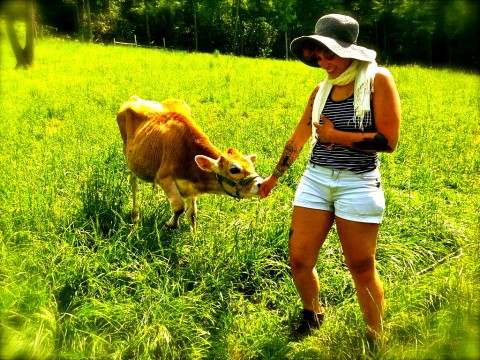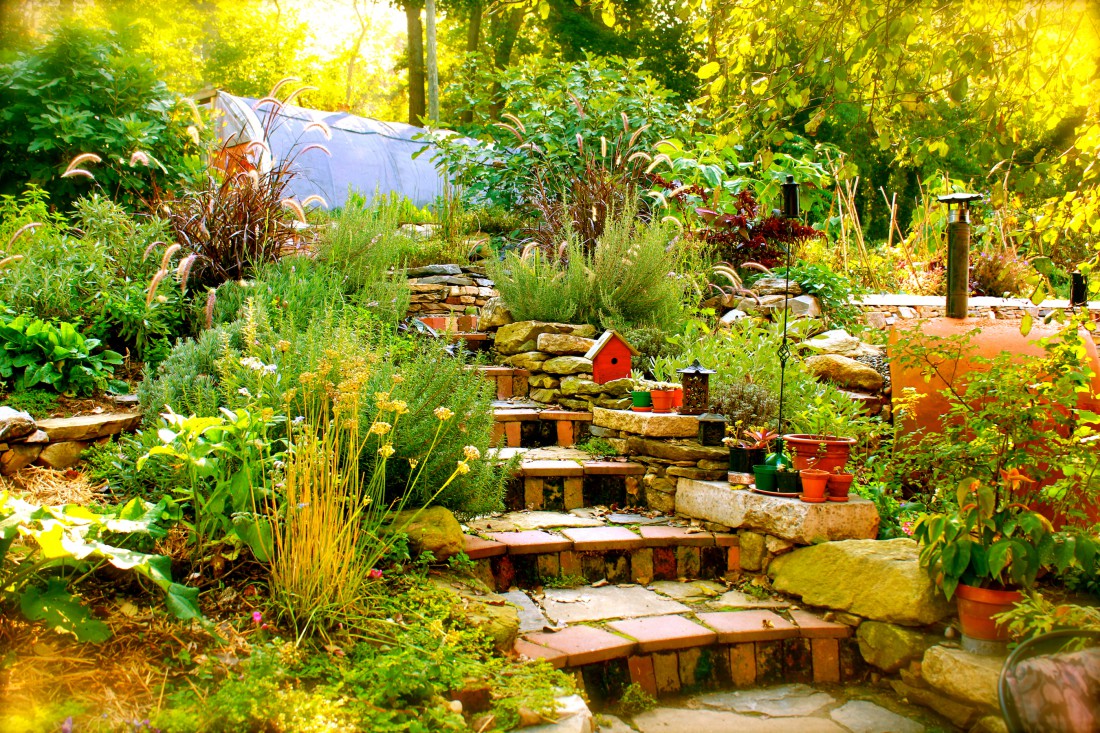In her Southern opus Gone With the Wind, Margaret Mitchell wrote, “The land is the only thing in the world worth working for, worth fighting for, worth dying for, because it’s the only thing that lasts.”
Thrive off of the land, and the land will thrive in return.
Learning to respect the land — from observing and interacting with nature or valuing renewable resources and producing no waste — is the foundation of permaculture, which is gaining attention throughout the country and in Western North Carolina. And local advocates say that Asheville and WNC are at the heart of cutting-edge, sustainable land use, which can be used in backyards, at schools, in businesses — or brought to complete fruition at places like Black Mountain’s Earthaven, a self-sustaining, “off-the-grid” eco-village where residents learn bit by bit to develop a symbiotic relationship with the environment.
But defining permaculture can be challenging.
What is permaculture?
The philosophy behind permaculture is defined by 12 principles written by co-originator of the concept, David Holmgren. The first principle is “observe and interact.”
“Beauty is in the eye of the beholder,” Holmgren writes. “By taking the time to engage with nature, we can design solutions that suit our particular situation.”
Other principles instruct the environmentally conscious to catch and store energy, obtain a yield, apply self-regulation and accept feedback, use and value renewable resources and services, produce no waste, design from patterns to details, integrate rather than segregate, use small and slow solutions, use and value diversity, use edges and value the marginal and creatively use and respond to change.
Janell Kapoor, founder of Ashevillage Institute, a local nonprofit dedicated to facilitating knowledge with an all-things-natural approach, says there are many ways to describe permaculture.
“You probably get a slightly different response to that question from anyone you ask,” she says. “In a nutshell, permaculture is really geared at looking at [the question], ‘How do we, as humans, consciously create and consciously design the living world and the systems and the interactions around us on a daily basis?’”
For Kapoor, part of permaculture is also creation. “We have the opportunity as intelligent beings — the opportunity to intentionally make choices and essentially design systems that are respecting and also in balance with the natural world around us,” she says.
Chuck Marsh, co-founder of Earthaven and of Living Systems Design, views permaculture through both a holistic and practical lens.
“Basically what permaculture is, is an eco- logical design system for the creation of regenerative human habitats,” says Marsh, who began studying the approach in 1981. “I also call it ‘applied common sense.’”
He says permaculture began as a permanent agriculture movement in Australia designed to enrich the soil and the landscape after destructive agriculture practices depleted natural nutrients. Part of permaculture, then, is building landscapes that become more productive over time, Marsh says, though that is not the whole picture.
“It’s really applying common-sense solutions to the challenges we as humans face in our world — with food security and depletion and exhaustion of natural resources,” Marsh continues. “We take a real, whole- systems approach to problem solving. We basically look for biological solutions and ecological solutions wherever possible to deal with whatever it is.”
You can see many of these principles in action at Earthaven, an off-the-grid community of about 175 people, nestled in a valley just outside Asheville. Earthaven, Marsh says, is part of a global ecovillage movement focusing on “how to live responsibly on the land in our care without depleting or exhausting it.”
“We’re just one of many pioneering efforts on land in the United States,” Marsh says. “We’re still here. We’re still at it. We’re still making mistakes and learning and growing and adapting.”

Whole-system solutions
Another way to understand permaculture is to think of it as a cyclical system where problems should also be viewed as solutions, says Zev Friedman, vice president of Living Systems Design, which provides permaculture consultation and education to clients around WNC.
An example Friedman gives is of a North Asheville property with an invasive-plant problem. Instead of using herbicides or harmful chemicals, Friedman developed an idea based on the natural instincts of certain animals and plants — and, using the principles of permaculture design, he established a 60-foot long, 6-foot wide chicken run along his client’s property.
“Chickens have a tendency to scratch land down to the bare dirt,” he says. “You can use that tendency of chickens to prevent plants that you don’t want from getting established. The chickens would patrol that edge, which lets the chickens do what they naturally want to do, but creates it into an asset.”
Another solution: “Plant a thick hedge of elderberries. It grows really fast and produces an edible, highly medicinal berry — prevents flus and colds and all sorts of viruses. And it out-competes other plants because it grows so fast.”
From the session, Friedman learned his clients were also having an issue with water running off their roofs and across their lawns, so the needs of the elderberries presented the perfect solution to that problem as well.
“The elderberries themselves are water-loving,” Friedman explains. “We diverted [the runoff from the roof] into little pits in the ground that will flow the water down, and the elderberries will grow from that water. The water that was running off the roof now nourishes the elderberries.”
In short, Friedman says, “We take all these things that were problems and turn them into solutions.”
Practical Applications
“There are lots of pathways to permaculture,” says local permaculturist Justin Holt. “Since I decided I wanted to become a permaculturist, I’ve realized it’s not just some- thing that can be isolated as ‘one’s job.’ When you really start to get the principles in your bones, really understand the ethics and how to derive your actions from those ethics, your whole life becomes part of this big, living system.”
Holt runs Kudzu Cowboy, a company that helps clients to transition into permaculture design and installations — what he calls “restoration landscaping.” He specializes in kudzu management and removal — using the raw materials of the plant to make baskets and fiber crafts and extracting root starch for cooking and medicinal purposes.
For people looking to learn how to apply permaculture to their daily lives and their home, Holt recommends thinking back to the founding principles of permaculture: care of the earth, care of the people, sharing the surplus and honoring the intrinsic value of all life.
“I always refer back to those core ethics be- cause it’s a really great grounding for starting to think about permaculture and for deciding what you want to do,” Holt says.
For the home gardener and landscaper, Holt suggests simple starter techniques: garden with perennials, start composting and stop fretting about the height of your grass.
“If you stop mowing your yard for just one year, it’s going to move pretty rapidly into an early successional forest,” Holt says.
In place of that micromanaged lawn, you could have a fruit and nut orchard or an edible forest garden, Holt says. And while each situation is unique, you can find what plants want to grow in your lawn just by looking at what grows around the edges where you didn’t mow or the weeds that you’re pulling out. Holt says that the first step towards understanding and implementing permaculture is cultivating an awareness of what already wants to grow on your property and understanding how those plants fit your needs.
“A lot of those weeds are actually trees, or would be if you let them grow,” Holt says. “And there are lots of useful perennials plants that you can introduce if you didn’t want to let the lawn become a forest.”
Elderberry is a great native perennial, Holt says. He also recommends sochan (also called green-headed coneflowers) and comfrey, which he calls “a wonder plant in permaculture.”
Other favorites? “Chickweed, which is a re- ally nutritious green. And lamb’s quarters, which is often pulled out [and treated] as a weed but is very rich in vitamin A. In fact, it has way more nutrients than many of the wimpy lettuces imported from Europe that are more popular in gardens.”
Whole-system solutions
Permaculture, enthusiast say, is fundamentally a solution-oriented practice. No matter where we are in the world, we can apply these principles and come up with solutions to live a sustainable life.
Friedman points to the example of the black soldier fly, which eliminates the problem of excess manure in animal en- closures. Ecosystems, like permaculture, Friedman says, allow for “this kind of design process — helping us to deal with situations where we have pollutants, and enter them into actual opportunities in- stead of problems.
“And that was really hopeful and captivating to me,” he says.
Friedman also says that there couldn’t be a better place to learn than WNC.
“There’s so much going on — seriously,” he says. “It’s actually a really exciting time to be in Asheville and this area. This is one of the leading places in the whole country for cutting-edge sustainable land use.”
Marsh adds, “There’s a rich treasure trove around this area of really good programs — specifically permaculture or some of them that might be various aspects of what we do, property consulting and design.”
For beginning permaculture enthusiasts, Holt suggest studying the principles and literature while also trying a few forays into foraging as a way to develop a working knowledge of the plants and animals that are already around you.
“Let grow what wants to grow here and learn how to use it,” Holt says. “The generosity of the landscape is overwhelming if you have the eyes to see it and appreciate it.”




Before you comment
The comments section is here to provide a platform for civil dialogue on the issues we face together as a local community. Xpress is committed to offering this platform for all voices, but when the tone of the discussion gets nasty or strays off topic, we believe many people choose not to participate. Xpress editors are determined to moderate comments to ensure a constructive interchange is maintained. All comments judged not to be in keeping with the spirit of civil discourse will be removed and repeat violators will be banned. See here for our terms of service. Thank you for being part of this effort to promote respectful discussion.